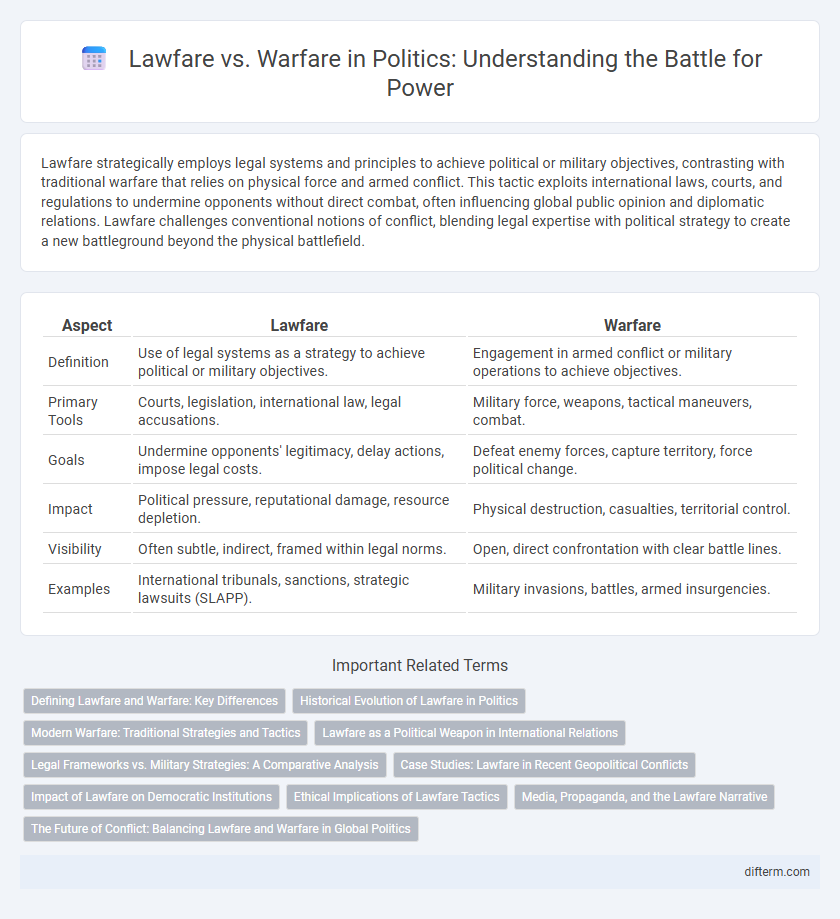Lawfare strategically employs legal systems and principles to achieve political or military objectives, contrasting with traditional warfare that relies on physical force and armed conflict. This tactic exploits international laws, courts, and regulations to undermine opponents without direct combat, often influencing global public opinion and diplomatic relations. Lawfare challenges conventional notions of conflict, blending legal expertise with political strategy to create a new battleground beyond the physical battlefield.
Table of Comparison
| Aspect | Lawfare | Warfare |
|---|---|---|
| Definition | Use of legal systems as a strategy to achieve political or military objectives. | Engagement in armed conflict or military operations to achieve objectives. |
| Primary Tools | Courts, legislation, international law, legal accusations. | Military force, weapons, tactical maneuvers, combat. |
| Goals | Undermine opponents' legitimacy, delay actions, impose legal costs. | Defeat enemy forces, capture territory, force political change. |
| Impact | Political pressure, reputational damage, resource depletion. | Physical destruction, casualties, territorial control. |
| Visibility | Often subtle, indirect, framed within legal norms. | Open, direct confrontation with clear battle lines. |
| Examples | International tribunals, sanctions, strategic lawsuits (SLAPP). | Military invasions, battles, armed insurgencies. |
Defining Lawfare and Warfare: Key Differences
Lawfare involves using legal systems and principles as strategic tools to achieve military or political goals, often through litigation or international law, contrasting with conventional warfare that employs physical violence and armed conflict. While warfare relies on direct force to dominate opponents, lawfare seeks to delegitimize or constrain adversaries by leveraging legal frameworks and public opinion. Understanding these differences highlights how states and non-state actors use lawfare as a non-violent extension of conflict to influence geopolitical outcomes.
Historical Evolution of Lawfare in Politics
Lawfare, the strategic use of legal systems to achieve political or military objectives, has evolved significantly since its origins during the Cold War, when international law began to be leveraged as a tool of non-kinetic conflict. In recent decades, major powers and non-state actors increasingly employ lawfare to undermine adversaries, shaping global diplomacy and warfare through international courts, sanctions, and compliance mechanisms. Historical milestones such as the Nuremberg Trials and the establishment of the International Criminal Court illustrate how legal frameworks have been institutionalized to influence power dynamics beyond traditional battlefield engagements.
Modern Warfare: Traditional Strategies and Tactics
Modern warfare increasingly integrates lawfare, where legal frameworks and judicial processes are leveraged as strategic tools to undermine opponents without direct military confrontation. Traditional tactics such as ground assaults and aerial bombardments are complemented by legal battles in international courts, creating a dual-front conflict environment. This fusion challenges conventional military doctrines by embedding legal challenges into the strategic calculus of modern conflicts.
Lawfare as a Political Weapon in International Relations
Lawfare, the strategic use of legal systems and principles to achieve political or military objectives, has emerged as a potent tool in international relations, enabling states to bypass conventional warfare costs and risks. This method leverages international law, courts, and regulations to delegitimize adversaries, impose sanctions, or constrain military actions without engaging in direct conflict. As a political weapon, lawfare reshapes power dynamics by framing disputes within legal narratives that influence global public opinion and diplomatic negotiations.
Legal Frameworks vs. Military Strategies: A Comparative Analysis
Legal frameworks in lawfare prioritize international statutes, treaties, and judicial processes to challenge and delegitimize opponents, contrasting sharply with military strategies that rely on force projection, battlefield tactics, and physical dominance. Lawfare employs precise interpretations of human rights laws, rules of engagement, and sovereignty principles to achieve political objectives without direct combat. Military strategies emphasize kinetic operations, logistics, and command structures to secure territorial control and neutralize threats through conventional or asymmetric warfare.
Case Studies: Lawfare in Recent Geopolitical Conflicts
Case studies of lawfare in recent geopolitical conflicts reveal how states employ international law as a strategic tool to undermine adversaries without direct military engagement. For example, Russia's use of legal claims in Crimea and China's maritime sovereignty assertions in the South China Sea exemplify lawfare to legitimize territorial expansion and influence global opinion. These instances highlight lawfare's role in reshaping conflict dynamics by leveraging international legal frameworks to achieve strategic geopolitical objectives.
Impact of Lawfare on Democratic Institutions
Lawfare strategically exploits legal systems to undermine democratic institutions by weaponizing legislation and judicial processes against political opponents, eroding public trust and destabilizing governance. This manipulation of laws weakens checks and balances, enabling authoritarian tendencies and diminishing the accountability of elected officials. The persistent use of lawfare compromises the integrity of democratic norms, threatening the rule of law and civic participation.
Ethical Implications of Lawfare Tactics
Lawfare tactics exploit legal systems to achieve military or political objectives, often blurring the lines between legitimate legal processes and strategic manipulation. Ethical concerns arise as these tactics can undermine justice, erode trust in legal institutions, and weaponize law to inflict harm without traditional warfare. The deployment of lawfare challenges norms of international law by prioritizing strategic advantage over the fair application of legal principles.
Media, Propaganda, and the Lawfare Narrative
Lawfare leverages media and propaganda to shape public perception by framing legal battles as moral crusades, contrasting with traditional warfare's physical combat. Media outlets often amplify lawfare narratives, using selective reporting and opinion pieces to influence political discourse and legitimize legal actions as instruments of justice. This strategic use of law and information warfare aims to delegitimize opponents, manipulate international opinion, and achieve political objectives without direct military conflict.
The Future of Conflict: Balancing Lawfare and Warfare in Global Politics
The future of conflict in global politics increasingly hinges on the balance between lawfare and warfare, where states leverage international law and judicial mechanisms to achieve strategic objectives without direct military engagement. Lawfare serves as a tool to delegitimize opponents and gain diplomatic advantages, while traditional warfare remains a crucial means of power projection and territorial control. Understanding this interplay is essential for policymakers to navigate complex security environments and develop comprehensive approaches to conflict resolution.
lawfare vs warfare Infographic

 difterm.com
difterm.com